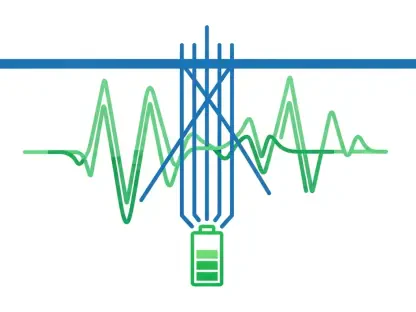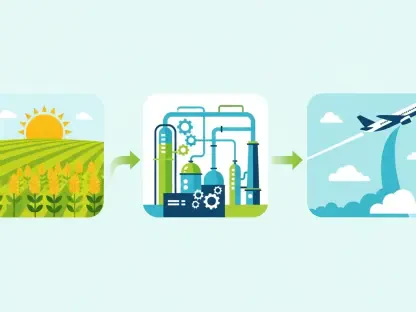In a world where the urgency to combat climate change is no longer a distant concern but a pressing reality, Europe stands at the forefront of a transformative energy shift, with the Paris Pledge emerging as a pivotal force to drive this change. Unveiled by the International Hydropower Association (IHA), this ambitious initiative seeks to harness the potential of Pumped Storage Hydropower (PSH) to anchor the continent’s transition to a sustainable, renewable-dominated energy grid. As wind and solar power continue to surge, their inherent unpredictability poses significant challenges to maintaining a stable energy supply. The Paris Pledge offers a bold response, uniting industry stakeholders and policymakers in a shared mission to amplify PSH capacity and secure a greener tomorrow. Far from a mere statement of intent, this commitment lays out actionable steps to address the intermittency of renewables while aligning with Europe’s stringent climate goals under the European Green Deal. This article explores the multifaceted dimensions of the Paris Pledge, delving into how PSH can serve as the backbone of renewable integration, the specific industry promises and policy needs it outlines, and the broader implications for sustainability and energy security across the region. By examining these elements, a clearer picture emerges of how this initiative could redefine Europe’s approach to clean energy, ensuring not just environmental progress but also economic resilience and grid reliability in the face of evolving global challenges.
Unpacking the Role of Pumped Storage Hydropower
Pumped Storage Hydropower (PSH) stands as a proven and indispensable technology in the quest to balance energy supply and demand, particularly as Europe leans heavily into renewable sources. Operating on a simple yet effective principle, PSH utilizes two reservoirs at varying elevations to store energy by pumping water uphill during periods of surplus electricity, then releasing it downhill through turbines to generate power when demand exceeds production. This mechanism positions PSH as a critical buffer, smoothing out the fluctuations inherent in wind and solar energy, which depend on weather conditions for output. By acting as a large-scale battery for the grid, PSH ensures that excess renewable energy isn’t wasted and can be deployed precisely when needed, reducing the reliance on fossil fuel backups. This capability is not just a technical advantage but a cornerstone for achieving long-term decarbonization targets, as it enables a higher penetration of clean energy into the system without compromising stability. The significance of PSH becomes even more pronounced when considering the projected energy mix, with renewables expected to account for 86% of Europe’s generation capacity by 2050. Without robust storage solutions like PSH, the vision of a fully renewable grid risks faltering under the weight of intermittency challenges.
While PSH has been a part of Europe’s energy infrastructure since the 1980s, its relevance has grown exponentially in tandem with the rapid expansion of renewable capacity across the continent, making it a cornerstone in the transition to sustainable energy. Today, as grids become increasingly complex and interconnected, the ability of PSH to provide long-duration storage—spanning hours or even days—sets it apart from other technologies that often fall short in addressing extended gaps in renewable output. Unlike short-term battery solutions, PSH offers a scalable and durable answer to the problem of energy reliability, ensuring that power remains available during prolonged periods of low wind or sunlight. Furthermore, its established track record provides a level of confidence for investors and policymakers looking to prioritize technologies with minimal risk and proven efficacy. As Europe pushes forward with ambitious plans to phase out carbon-intensive energy sources, PSH emerges as a linchpin in maintaining grid resilience, preventing blackouts, and supporting the seamless integration of clean power. The renewed focus on this technology through initiatives like the Paris Pledge underscores its untapped potential to transform the energy landscape, making it a vital component of any serious strategy aimed at achieving climate neutrality.
The Paris Pledge: A Catalyst for Transformation
The Paris Pledge, introduced by the International Hydropower Association, represents a landmark commitment to accelerate the deployment of Pumped Storage Hydropower as a fundamental pillar of Europe’s clean energy transition. This initiative brings together key players in the hydropower sector to align their efforts with the continent’s overarching environmental objectives, including the goals set forth by the European Green Deal. Structured into two core components, the Pledge combines an industry-driven promise to expand PSH infrastructure with a targeted appeal for regulatory support to eliminate barriers to growth. The ultimate aim is to facilitate a grid where variable renewables dominate, ensuring energy security while driving sustainable industrial progress. Beyond mere infrastructure development, the Pledge champions innovation in storage solutions and promotes cross-border collaboration, positioning Europe as a global frontrunner in green technology adoption. It’s a comprehensive vision that seeks not only to meet numerical targets but to fundamentally reshape how energy systems operate in the face of rising demand and climate imperatives, setting a precedent for coordinated action across sectors.
Central to the Paris Pledge is the audacious goal of doubling Europe’s PSH capacity by 2050, a target that reflects both the scale of ambition and the urgency of the climate challenge, highlighting the critical need for sustainable energy solutions. This expansion isn’t limited to constructing new facilities but also encompasses the modernization of existing plants to enhance efficiency and minimize environmental footprints. The initiative underscores the importance of integrating advanced technologies, such as smart grid systems, to optimize performance and adaptability. Additionally, the Pledge emphasizes the need for a strengthened supply chain within Europe, ensuring that the materials and expertise required for PSH projects are locally sourced and readily accessible. This focus on regional self-reliance not only boosts economic growth but also reduces vulnerabilities to global supply disruptions. By fostering a collaborative environment where industry stakeholders commit to tangible outcomes, the Paris Pledge lays a robust foundation for transforming Europe’s energy infrastructure, promising a future where clean power is both abundant and dependable, even under the most demanding conditions.
Bridging the Gap with Long-Duration Storage
A defining strength of the Paris Pledge lies in its recognition of long-duration energy storage as a non-negotiable element in Europe’s renewable energy journey, with pumped storage hydropower (PSH) positioned as the most viable solution to this complex challenge. As the share of wind and solar power in the energy mix grows—projected to reach 86% by 2050—their intermittent nature creates significant hurdles for grid operators striving to match supply with demand. PSH addresses this by storing surplus energy during periods of high production and releasing it during shortages, effectively bridging the temporal gaps that renewables alone cannot fill. This capability reduces the need for fossil fuel-based reserve systems, which often serve as a fallback during low renewable output, thereby accelerating the decarbonization of the energy sector. The emphasis on long-duration storage within the Pledge highlights a strategic understanding that short-term fixes are insufficient for a grid increasingly reliant on variable sources, positioning PSH as an essential tool for achieving both environmental and operational goals.
Moreover, the role of PSH extends beyond mere storage to encompass broader grid stability, a critical factor as Europe’s energy networks become more intricate and interdependent. Sudden fluctuations in demand or unexpected drops in renewable generation can destabilize systems, risking outages or inefficiencies. PSH mitigates these risks by providing a rapid-response mechanism, releasing stored energy to smooth out imbalances almost instantaneously. This reliability is indispensable in an era where energy consumption patterns are evolving with the rise of electric vehicles and smart technologies, which place additional strain on existing infrastructure. The Paris Pledge’s focus on scaling up PSH capacity directly tackles these emerging pressures, ensuring that the grid remains robust against both predictable cycles and unforeseen disruptions. By prioritizing this technology, the initiative not only supports climate objectives but also safeguards the day-to-day functionality of energy systems, reinforcing public trust in the transition to renewables as a practical and sustainable endeavor.
Industry Promises: Scaling Up with Innovation
Under the framework of the Paris Pledge, the hydropower industry has outlined a series of concrete commitments that signal a proactive stance toward expanding Pumped Storage Hydropower across Europe. Chief among these is the pledge to double PSH capacity by 2050, a target that necessitates significant investment in both new projects and the refurbishment of aging facilities. This expansion is designed to meet the rising demand for storage as renewable energy sources dominate the grid, ensuring that infrastructure keeps pace with evolving needs. Beyond sheer scale, the industry is focused on improving operational efficiency through modernization efforts, integrating state-of-the-art designs that reduce energy loss and enhance output. Such upgrades are vital for maximizing the impact of each PSH plant, allowing them to contribute more effectively to grid stability while minimizing resource use. This ambitious roadmap reflects a deep understanding of the technical and financial challenges ahead, positioning the sector as a driving force in Europe’s clean energy landscape.
Equally significant is the industry’s commitment to innovation and workforce development as outlined in the Paris Pledge, ensuring that PSH projects remain at the cutting edge of technology and human capital. Embracing digital tools like predictive maintenance systems and smart grid integration allows for real-time monitoring and optimization of PSH operations, boosting both reliability and environmental performance. Simultaneously, efforts to strengthen the European supply chain aim to secure the materials and expertise necessary for sustained growth, reducing dependency on external markets and fostering economic resilience. The sector also prioritizes building a skilled workforce through training programs and knowledge-sharing initiatives, with an emphasis on diversity and inclusion to tap into a broader talent pool. Transparent engagement with local communities forms another pillar, ensuring that the benefits of PSH—such as job creation and energy security—are equitably shared, thereby fostering social acceptance. These multifaceted promises underscore a holistic approach to development, balancing technical advancement with societal and economic considerations.
Policy Imperatives: Building a Supportive Framework
The Paris Pledge acknowledges that industry efforts alone cannot fully unlock the potential of Pumped Storage Hydropower without a complementary push for regulatory reform, making policy support a critical component of the initiative. A key demand is the prompt adoption of the Renewable Energy Directive III, which would include provisions for cross-border cooperation and innovative storage solutions, facilitating regional collaboration on PSH projects. Additionally, the Pledge calls for the elimination of double grid fees and discriminatory charges that disproportionately burden PSH operators, often rendering projects less competitive compared to other energy sources. By addressing these financial disincentives, policymakers can level the playing field, recognizing the systemic value of PSH in stabilizing grids and enabling renewable integration. These proposed changes are not mere suggestions but essential steps to create an environment where investment in storage technology can flourish, aligning regulatory frameworks with the urgent need for sustainable energy solutions.
Further deepening the call for policy action, the Paris Pledge advocates for mechanisms that provide financial certainty and reduce bureaucratic hurdles for PSH development. Introducing revenue stabilization tools, such as capacity markets or cap-and-floor schemes, would offer long-term predictability for investors, making projects more bankable and attractive. Streamlined permitting processes, harmonized across EU and national levels with clear timelines, are also crucial to prevent delays that can derail momentum. Moreover, recognizing PSH as critical infrastructure within energy strategies could unlock access to funding under the EU Green Deal, while setting binding targets for long-duration storage deployment would maintain accountability and focus. These measures collectively aim to dismantle systemic barriers that have historically slowed the rollout of PSH, ensuring that regulatory frameworks evolve in tandem with technological and industry advancements. The emphasis on policy alignment reflects a pragmatic understanding that systemic change requires collaboration between public and private sectors to achieve lasting impact.
Embedding Sustainability and Social Responsibility
Sustainability forms a core tenet of the Paris Pledge, with the hydropower industry committing to rigorous standards that minimize the environmental impact of Pumped Storage Hydropower (PSH) projects. This involves adopting evidence-based approaches to monitor and mitigate ecological disruptions, ensuring compliance with stringent EU guidelines. From the planning phase through to operation, every stage of PSH development is expected to prioritize reducing effects on local ecosystems, such as water quality and biodiversity, while optimizing land use to avoid unnecessary encroachment. This dedication to environmental stewardship is not just about meeting regulatory requirements but about setting a higher benchmark for responsible infrastructure growth. By integrating such principles, the Pledge seeks to demonstrate that large-scale energy projects can coexist with nature, addressing public concerns over the ecological footprint of industrial activities and reinforcing the credibility of PSH as a green solution in the broader energy transition narrative.
Parallel to environmental considerations, the Paris Pledge places significant emphasis on social responsibility, recognizing that community support is vital for the success of PSH initiatives and engaging with local stakeholders from the earliest stages of project development. This key promise is aimed at fostering trust and ensuring that concerns are heard and addressed transparently. The industry commits to sharing the economic and social benefits of PSH, such as job opportunities and enhanced energy security, with host communities to create a sense of shared value. This approach seeks to minimize opposition and build lasting partnerships, acknowledging that social acceptance can often determine the feasibility of infrastructure projects. By prioritizing open dialogue and equitable benefit distribution, the Pledge sets a standard for how energy developments should interact with the public, ensuring that the push for a cleaner grid also translates into tangible improvements for those directly impacted by such projects, thus weaving social justice into the fabric of Europe’s energy future.
Charting the Path Ahead for Europe’s Energy Transition
Reflecting on the journey so far, the Paris Pledge has crystallized a powerful vision for how Pumped Storage Hydropower could underpin Europe’s clean energy ambitions, marking a significant moment of collective resolve among industry leaders and advocates. Its unveiling by the International Hydropower Association served as a clarion call, uniting diverse stakeholders around a shared commitment to scale up PSH infrastructure while advocating for the policy reforms needed to make it viable. By addressing the inherent intermittency of renewable sources, bolstering grid reliability, and embedding sustainability at every level, the initiative positioned PSH as a vital asset in the continent’s pursuit of climate neutrality. The dual focus on actionable industry steps and regulatory support underscored a nuanced grasp of the challenges that had long hindered progress in energy storage, offering a balanced strategy to overcome them.
Looking to the future, the next steps for realizing the full potential of the Paris Pledge involve sustained collaboration and a willingness to adapt to emerging obstacles, ensuring that all stakeholders are aligned in their commitment to a sustainable energy transition. Stakeholders must prioritize securing the necessary funding to meet ambitious capacity targets, exploring innovative financing models to complement public investments. Governments, in turn, should act decisively to implement the proposed regulatory changes, ensuring that pumped storage hydropower (PSH) is integrated into national energy plans as a priority. Continuous dialogue with communities will remain essential to maintain trust and address evolving concerns, while advancements in technology should be leveraged to further enhance project efficiency. As Europe navigates the intricate path toward a renewable-driven grid, the legacy of the Paris Pledge could inspire similar frameworks in other sectors, proving that collective action, paired with strategic policy, holds the key to unlocking sustainable progress on a global scale.









